

How to Prepare a PhD Research Plan/Schedule?
PhD research plan is a structured schedule for completing different objectives and milestones during a given timeframe. Scholars are usually unaware of it. Let us find out how to prepare it.
Between March 2021 to 2022, I read almost 15 different research proposals from students (for their projects) and only a single one, I found, with a comprehensive research plan for 3 years. Which is still not, kind of practical, probably copied from other students.
Such entities are not known to over 90% of students, if some know that because their university asked for but unfortunately, this basic procedure lacks penetration among students. I don’t know the exact reason, but students lack a basic understanding of the research process.
Meaning, that they don’t know or perhaps don’t complete their course work needly. PhD research requires many documents, SOPs and write-ups, before even starting it. For example, a rough research plan, research proposal, initial interview, competence screening, grant proposal and so on.
However, the requirement varies among universities and thus knowledge regarding basic procedures often also varies among students. So I’m not blaming students but certainly, it is the fault of the university side, as well.
When you come up with a research proposal with a research schedule or entire plant, certainly it will create a positive image and good reputation. So it is important. But how to prepare it?
Hey, there I’m Dr Tushar, a PhD tutor and coach. In this article, we will understand how we can prepare a structured plan for the PhD research and how to execute it.
So let’s get started.
How to prepare a PhD research plan/schedule?
A PhD research plan or schedule can be prepared using the GANTT chart which includes a month, semester or year-wise planning of the entire PhD research work.
First, enlist goals and objectives.
It’s not about your research objective enlisted in your proposal. I’m talking about the objectives of your PhD. Take a look at some of the objectives.
Note that these are all the objectives that should be completed during the PhD, but not limited to a specific subject. Note you have to show how you can complete or achieve each objective during the entire tenure of your work.
And that is what the plan/schedule is all about. Next, explain the time duration. The time required to complete each goal, roughly. For example, a semester or a year to complete the course work or 4 to 8 months for completion of ethical approval.
Now two things must be known to you, at this point in time.
- First, enlist the time required to complete each objective, as aforementioned.
- Second, what goals would you complete during each semester?
For instance, course work takes a semester to complete, but during the period a scholar can also craft their PhD research title, research proposal, ethical approval and grant proposals.
Now it is also crucial to know that there is no time bound to complete goals, but it should be completed as you explained. Let’s say you can plant it for 3 years, 4 or even 5 years depending on the weightage of your work.
In summary, the answer to the question of how to prepare a research plan is,
- Enlist your goals or objectives.
- Decide the time required to complete each goal.
- Prepare a GANTT chart.
Now you have prepared zero-date planning for your research but how to present it? The answer is a GANTT chart.
GANTT chart for PhD research plan:
GANTT chart is a task manager and graphical presentation of how and how many tasks are completed or should be completed against a given time duration. Take a look at the image below.
How can you prepare one?
Open MS Excel (on Windows) or numbers (on Mac).
Enlist goals or objectives in a column.
Enlist years (duration of PhD) in a row and bifurcate them into individual semesters. You can also prepare a month-wise plan, that’s totally up to you. In my opinion, semester-wise planning is good because research is a lengthy and time-consuming process. So monthly planning would not work.
To make a chart more attractive and readable use colors, as I used. Now mark a ‘cell’ against a column and row showing the objective which you are going to complete in a semester. Take a look.
After the end of this, your GANTT chart would look like this.
You can prepare a month-wise planning, individual semester-wise planning and goal-wise planning etc. I will explain these things in upcoming articles on 5 different types of GANTT charts for PhD.
Custom writing services:
If you find difficulties in preparing a research plan, synopsis, proposal or GANTT chart. We can work on behalf of you. Our costume services are,
- Synopsis writing
- Project writing
- Research proposal writing
- Research planning and GANTT chart preparation.
You can contact us at [email protected] or [email protected] to get more information.
Wrapping up:
Planning and executing a research schedule are two different things. Oftentimes, students just prepare as per the requirements and then do work as per their convenience. Then they are stuck in one place and just work around the time.
Plan things. Make your own GANTT chart, put it on your work table or stick it on a wall so that you can see it daily. Try to achieve each goal in time. Trust me things will work and you will complete your PhD before anyone else.

Dr. Tushar Chauhan is a Scientist, Blogger and Scientific-writer. He has completed PhD in Genetics. Dr. Chauhan is a PhD coach and tutor.
Share this:

- Share on Facebook
- Share on Twitter
- Share on Pinterest
- Share on Linkedin
- Share via Email
About The Author

Dr Tushar Chauhan
Related posts.

Why is it called a Doctor of Philosophy?

Preparing for a PhD Viva
Leave a comment cancel reply.
Your email address will not be published. Required fields are marked *
Save my name, email, and website in this browser for the next time I comment.
Notify me of follow-up comments by email.
Notify me of new posts by email.
- Interesting
- Scholarships
- UGC-CARE Journals
12 Expert Tips for Organizing Your PhD Research work
Revolutionize Your Research Workflow with These Expert Organization Tips

Table of contents
1. set clear goals, 2. develop a research plan, 3. create a schedule, 4. use a project management tool, 5. prioritize your tasks, 6. break down large tasks into smaller ones, 7. manage your time effectively, 8. stay organized, 9. communicate with your supervisor, 10. seek support, 11. stay motivated, 12. take breaks, 50 tips to oranize phd research work.
The journey of pursuing a PhD can be an exciting and rewarding experience, but it can also be overwhelming at times. One of the keys to completing the PhD degree successfully is being organized and managing your time effectively.
Organizing PhD work can be a challenging task, but with proper plan and execution, one can effectively manage their time and progress. In this article, iLovePhD presented twelve practical tips and strategies to help you stay organized and productive during your PhD journey.
Whether you’re just starting or in the middle of your PhD journey, these tips will help you stay on track and make the most out of your time as a research scholar.
Tips to Revolutionize Your PhD Research Workflow
The first step in organizing your PhD work is to set clear goals for yourself. Define the objectives of your research. Develop a clear and realistic plan for your PhD work, including milestones and deadlines for each task.
Once you have set your goals, develop a research plan that outlines the steps you need to take to achieve them. Your research plan should include the research questions you want to answer, the methods you will use to collect data, and the analysis techniques you will use to draw conclusions.
Create a schedule that outlines the tasks you need to complete each week and the deadlines for completing them. Make sure you allocate enough time for each task and don’t forget to include time for reviewing and revising your work.
Consider using a project management tool like Trello, Asana, or Notion to help you organize your tasks, set deadlines, and to help you to stay on track.
Prioritize your work based on the importance and urgency of each task. This will help you to focus on the most critical work first.
Also Read: Suffering PhD Scholars in Academia
Divide large tasks into smaller, more manageable tasks. This will help you to work more efficiently and achieve progress more quickly.
Manage your time effectively by allocating specific time slots for each task. Avoid multitasking, which can reduce your productivity and increase your stress levels.
Keep your work organized by using folders, files, and notes. This will help you to easily find and access your work and prevent you from losing important documents. Use tools like Zotero or Mendeley to manage your references.
Regular communication with your supervisor is crucial for staying on track with your PhD work. Schedule regular meetings with your supervisor to discuss your progress, get feedback, and ask for help if needed.
Seek support from your peers, and other professionals when necessary. This can help you to overcome challenges and move forward in your research
Stay motivated by setting realistic goals for yourself and celebrating your achievements.
Taking regular breaks is important to avoid burnout and stay focused. Make sure to schedule time for self-care. Engage in activities that you enjoy to maintain your mental health and well-being.
Organizing your PhD work is essential to ensure that you can work efficiently and effectively toward your research goals. It is an ongoing process, and you may need to adjust your plan as you go along.
- Develop a system for managing your data.
- Use a literature review matrix to stay organized.
- Prioritize self-care to avoid burnout.
- Use a task management tool to stay on top of deadlines.
- Keep a research journal to track progress and ideas.
- Stay organized by using folders and labels.
- Create a clear and concise research plan.
- Break larger tasks into smaller, manageable ones.
- Use a citation management tool to keep track of sources.
- Take breaks to avoid fatigue and maintain focus.
- Back up your data regularly.
- Use templates for reports and presentations to save time.
- Stay on top of emails and communication.
- Use an agenda or planner to schedule meetings and deadlines.
- Collaborate with others to share ideas and resources.
- Use software tools to help automate repetitive tasks.
- Take advantage of library resources and research guides.
- Use charts and graphs to visualize data.
- Use cloud-based storage to access your work from anywhere.
- Stay organized by color-coding notes and files.
- Use checklists to ensure you complete all necessary tasks.
- Make time for exercise and other forms of self-care.
- Keep track of important dates and events.
- Break down complex information into easy-to-understand summaries.
- Use mind-mapping software to brainstorm ideas.
- Take notes during meetings and discussions.
- Create a filing system for physical documents.
- Use an annotation tool to mark up documents.
- Set aside designated time for writing.
- Prioritize your most important tasks first.
- Use keywords to organize your literature reviews.
- Stay focused by eliminating distractions.
- Use a backup system to protect your work.
- Use templates to maintain consistent formatting.
- Utilize peer feedback to improve your work.
- Stay up-to-date on research trends and developments.
- Use time blocking to schedule your day.
- Maintain a consistent schedule to establish a routine.
- Use a timer to help with time management.
- Stay organized by using bookmarks and tags.
- Make use of keyboard shortcuts to save time.
- Take breaks to stretch and move your body.
- Stay hydrated and well-rested for optimal productivity.
- Use online forums to connect with other researchers.
- Take care of your mental health to stay focused and motivated.
- Keep your workspace clean and clutter-free.
- Use a dictation tool to speed up your writing.
- Create a backup plan in case of unexpected issues.
- Use technology to stay organized on the go.
- Celebrate your progress and accomplishments along the way!
By implementing the tips discussed in this article, you can establish a structured approach to your work that will help you stay focused and motivated. Be flexible and keep working towards your goals, and you will be on your way to completing your PhD successfully.
- academic success
- data management
- Literature Review
- productivity
- research journal
- research organization
- research work
- task management
Advantages and Disadvantages of Qualitative Research Methodologies
Do this… to accept your paper, top 10 ilovephd articles of 2023, email subscription.

iLovePhD is a research education website to know updated research-related information. It helps researchers to find top journals for publishing research articles and get an easy manual for research tools. The main aim of this website is to help Ph.D. scholars who are working in various domains to get more valuable ideas to carry out their research. Learn the current groundbreaking research activities around the world, love the process of getting a Ph.D.
WhatsApp Channel
Join iLovePhD WhatsApp Channel Now!
Contact us: [email protected]
Copyright © 2019-2024 - iLovePhD
- Artificial intelligence

- Youth Program
- Wharton Online
Wharton Stories
How to maximize and adjust to a phd schedule.
A PhD schedule takes adjustment, but the strategies that work for doctoral studies carry throughout an academic career.
Adjusting to a PhD schedule can be a challenge. Classes will take up a decent amount of your time for the first few years of a program. After completing the required courses, independent research becomes the main focus. Sometimes that can be intimidating. You become your own boss, which is an adjustment from being told what to do and when to do it.
Here are a few tips from current doctoral students and professors at Wharton on how to transition into this new lifestyle:
Brush Up on Your Time Management Skills
Learning how to manage your time more effectively can help you get your schedule under control as well as stay on task and reduce stress. Prof. Wayne Guay , the doctoral coordinator for the Accounting program, said, “Effective time management is crucial to success, progress and sanity. First, students should know they are not alone, as it is something that many — perhaps most — graduate students struggle with from time to time.”
Time management allows you to maximize your day. If you find yourself struggling to effectively manage your time, click here for helpful tips .

Ask for Help
Completing a PhD is not an easy task. There will be times when you’re struggling and may be feel unsure or overwhelmed. Prof. Fernando Ferreira , the doctoral coordinator for the Business Economics and Public Policy and Real Estate programs, suggested that students reach out for help. He said, “It’s always much better to talk people. Share the experience that’s happening and share the problem, usually that’s the best way to overcome that struggle. It’s much easier once you’re able to communicate what exactly is happening.”
Professors are there to guide you when you need, so take advantage of their expertise. If you don’t feel comfortable talking to a professor, talk to a peer. There’s a chance that others have experienced similar issues and can lend some helpful advice. Prof. Ferreira also suggested seeking help sooner rather than later as putting off a problem can cause further issues down the line.
Take a Break
From going to class, completing homework, and conducting research, your days can be jam-packed. Although it is important to focus on your work, it is also important to take time for yourself. Karren Knowlton , a third year Management student, said, “It’s super easy to feel like school is your life, but you won’t be able to bring your best self here if you don’t round yourself out in other ways. I would say maybe two nights a week try to see other people and do something outside of school even if it’s just for an hour.”
Whether grabbing dinner with a friend or joining on a club on campus, there is plenty to do in and around Philadelphia. Karren chooses to spend her free time volunteering with the Science Education Academy in West Philly. Karren said, “ It’s a fun and rewarding way to give something back to the local community that’s easy to work into a PhD student schedule.”
Don’t Compare Yourself to Others
Not comparing yourself to others is easier said than done. It’s important to remember a PhD program is not one size fits all. What works for one person may not necessarily work for you. Prof. Deborah Small , the doctoral coordinator for the Marketing program, said, “Of course it’s impossible to not compare yourself to others, but there’s not one right way to become an academic other than getting that degree.”
Comparing yourself to others can cause you to lose sight of the goal you’re working towards. Focus on what you personally need to do to be successful. Karren said, “Figure out what your priorities are and don’t let looking at other people and how much they seem to be working or not working affect that.”
Having tips to adjust to a PhD schedule is only helpful if you know what to expect. Get an inside look at the schedule of a PhD student .
Posted: August 4, 2017
- Philadelphia
Doctoral Programs
Start your doctoral journey.
Whether you’re just starting your research on PhD programs or you’re ready to apply, we’ll walk you through the steps to take to become a successful PhD candidate.
Deciding to get a PhD
You might be surprised to find out what you can do with a PhD in business.
Is an Academic Career for You ? What Makes a Successful PhD Student
Preparing for the Doctoral Path
The skills, relationships, and knowledge you need to prepare yourself for a career in academics.
How the PhD Program Works How to Become a Successful PhD Applicant
Choosing the right program
What’s the difference between PhD programs? Find out how to choose one that fits your goals.
What to Consider When Choosing a Doctoral Program What Differentiates R1 Universities?
Starting an application
Tips for a successful application process.
Application Requirements Preparing Your PhD Application
Related Content

How a Staffing Company Can Tackle Pressing Social Issues

How This Schwarzman Scholar Founded America’s Largest Student-Organized Summit on China

What this Wharton Professor Wants Students to Know About Customer Centricity

The Intersection of Advocacy and Academia: How Wharton Took Me to the Arctic

The Unintended Consequences of Google Search Results

How Wharton’s EMBA Program is Helping this Physician Impact Healthcare

Get to Know the 20 New Faculty Members Joining Wharton This Year

How a Personal Journey to Nutritional Balance Led This MBA to the Food Industry

Six Lessons from an EMBA Journey

How Wharton Helped this Engineer Transition to the Business Side of the Defense Industry

How an Undergrad Club Is Empowering Refugees in the Philadelphia Community and in the World at Large

ZEV: Helping Dealers Sell Electric Vehicles

How VisiPlate Is Curing Blindness With Nanotechnology

Wharton’s EMBA Program Gains Two New Concentrations in Healthcare, Business Analytics
![Lipman Family Prize Honorees Join Growing Global Network of Social Change-makers [Video] phd schedule of work](https://dca.wharton.upenn.edu/wp-content/uploads/2017/03/Lipmans-Hero-300x115.jpg)
Lipman Family Prize Honorees Join Growing Global Network of Social Change-makers [Video]

A PhD timeline for finishing quickly [Free Gantt Download]
Navigating the labyrinthine journey of a PhD program is no small feat.
From the day you step into your graduate program as a bright-eyed doctoral student, you’re immediately thrust into a complex weave of coursework, research, and milestones.
By the second year, you’ve transitioned from coursework to research, laying the groundwork for your dissertation—a pivotal component in your scholarly endeavour.
Come the third year, you face the critical oral examination, a hurdle that could make or break years of hard work.
But how does one streamline this multifaceted journey? The answer lies in a well-planned PhD timeline.
This blog serves as an invaluable guide for any PhD student looking to complete their doctoral studies efficiently, walking you through each milestone from coursework to graduation.
How to Begin with the PhD Timeline Planning?
Planning your PhD timeline is an essential first step in your PhD program.
Success in any PhD program depends, to a large extent, on effective time management and keeping track of progress through a thoughtfully crafted PhD timeline.
Start with outlining all your major requirements:
- coursework,
- dissertation,
- and the expected time needed for each task.
I also highly recommend factoring in failure time – give yourself a little bit of wiggle room for when things, invariably – go wrong.
It’s crucial to remain realistic about the time you can commit daily or weekly while keeping long-term goals in mind.
Regular check-ins on your PhD timeline and supervisor will help you stay on track and allow you to adapt if necessary.
Adjustments may be needed as you progress through your PhD program, but having a timeline as a guide can make the journey less daunting and more achievable.
Elements to include in a 3-year PhD timeline
The initial stage in this timeline typically involves coursework, often lasting one year, where the student engrosses themselves in advanced study in their chosen field.
Once the coursework is done (USA PhDs), they focus on proposing, conducting, and presenting their initial research.
By the end of the second year, most students should have a clear direction for their dissertation, a core component of the PhD process.
In this third and final year of the PhD timeline, the student focuses primarily on completing their dissertation, which involves collecting data, analyzing results, and organizing their research into a substantial, original, and cohesive document that contributes to contemporary knowledge in their field.
Regular reviews and modifications of the PhD timeline may also be necessary to accommodate various unpredictable circumstances, thus making this timeline both a guide and a flexible workplan.
It is a significant tool in successfully navigating the maze of becoming a PhD holder.
Create Your PhD Timeline for a 3 year completion
Creating a timeline for a 3-year PhD program requires careful planning, as you’ll have multiple milestones and tasks to complete.
This timeline may vary depending on your specific field, institution, or country, but here is a general outline you can use as a starting point:
Free Gantt chart excel template
Here is a free template you can modify for your own research:
Example Gantt chart for a USA PhD
Here are some common steps involved in completing a PhD, which I’ll use to create the Gantt chart:

- Orientation and Coursework (Semester 1) : Familiarization with the university, department, and coursework.
- Coursework (Semester 2) : Continued coursework and possible teaching/research assistantships.
- Select Advisor and Research Topic : Usually done towards the end of the first year or the beginning of the second year.
- Preliminary Research : Initial research and literature review.
- Complete Coursework (Semester 3) : Wrap up any remaining required courses.
- Research Proposal : Develop a full research proposal including methodology.
- Qualifying Exams : Exams to transition from a Ph.D. student to a Ph.D. candidate.
- Begin Research : Start of actual research based on the approved proposal.
- Conduct Research : Data collection, experiments, and analysis.
- Intermediate Review : A review to assess the progress of the research.
- Write Papers : Start writing papers and possibly publishing in journals.
- Finalize Research : Final experiments and data analysis.
- Write Dissertation : Writing the actual Ph.D. dissertation.
- Dissertation Defense : Defending the dissertation before the committee.
- Graduation : Completing all requirements and graduating.
Example Gantt chart for a UK, European and Australian PhD
For Ph.D. programs outside the United States, especially in Europe and some other parts of the world, students often go straight into research without the need for coursework. Here are some common steps for such programs:

- Orientation : Familiarization with the university and department.
- Select Advisor and Research Topic : Usually done at the beginning of the program.
Wrapping up
The journey to earning a PhD is complex and demanding, filled with academic milestones from coursework to research to dissertation writing.
The key to a smooth and efficient doctoral journey lies in well-planned time management—a structured PhD timeline.
This blog serves as an invaluable guide, offering detailed tips for planning out each academic year in both U.S. and international PhD programs. It emphasizes the importance of starting with an outline of major requirements and factoring in “failure time” for unforeseen challenges.
For those looking to navigate their PhD journey in three years or beyond, having a flexible but comprehensive timeline can be the compass that guides them successfully through the academic labyrinth.
Whether you’re just starting out or already deep into your research, the principles and strategies outlined here can help streamline your path to that coveted doctoral hood.

Dr Andrew Stapleton has a Masters and PhD in Chemistry from the UK and Australia. He has many years of research experience and has worked as a Postdoctoral Fellow and Associate at a number of Universities. Although having secured funding for his own research, he left academia to help others with his YouTube channel all about the inner workings of academia and how to make it work for you.
Thank you for visiting Academia Insider.
We are here to help you navigate Academia as painlessly as possible. We are supported by our readers and by visiting you are helping us earn a small amount through ads and affiliate revenue - Thank you!

2024 © Academia Insider

How to Manage Your PhD Timeline for Smoother Research Completion
It’s finally happening! The university has sent you an acceptance letter for the PhD program you had applied to. Getting into a doctoral program is not an easy task, and the speculations around it of being one of the toughest courses can’t be denied either. However, despite it being a daunting journey, one can smoothly sail through by managing the PhD timeline smartly. So sit back and read this article to plan your Ph.D. research timeline in an effective and hassle-free manner.
Table of Contents
Why Should You Draw a Ph.D. Timeline?
A PhD journey is laid with several milestones that come as you proceed. Thus, drawing a timeline preemptively helps researchers stay away from the last-minute terror of submissions, presentations, committee meetings, viva, etc. Furthermore, creating a timeline and adhering to it makes you a better learner and instills discipline in you.
How to Begin with the PhD Timeline Planning?
While creating a well-structured timeline, you must ask these questions to yourself and to your supervisor:
- What are the important steps of a PhD program?
- How many projects do you have to work on?
- What are the technical milestones for developing a protocol?
- What are the risks associated?
What to Do Before Creating Your PhD Timeline?
Obtaining a doctoral degree is a process of completing of required credits, passing the qualification test for submitting a doctoral thesis, writing and submitting a thesis, and final viva voce.
Follow these steps as you create your PhD Timeline :
- Attend the program orientation to understand specific graduation requirements
- Make a list of technical events such as conferences, committee meetings, PhD viva voce , presentations, qualification examination, etc.
- Manage your PhD timeline term-wise or month-wise
- Make a list of events on priority-basis
Step-wise Guide to Create Your PhD Timeline
Let’s take a detailed look at the steps required for a PhD. It is important to know what each step entails and what the deadline is for each of it. Generally, all universities have strict graduation requirements. A doctoral student is expected to complete a minimum number of credits to qualify as a PhD candidate. However, in some cases, a master’s degree is required for the doctoral program, and if you have obtained a master’s degree, you may be awarded a doctoral degree only through a research course without taking additional credits.
Here are 8 major milestones of a PhD program:
Milestone 1: Through consultation with your advisor, check whether there are any special graduation requirements other than the university and department that you may have to complete as part of your program.
Milestone 2: The supervisory committee must be formed within one year of the doctoral program and must have at least one meeting to plan the successful conclusion of a research project. In addition to the advisor, at least two other university professors are required to be members of this committee. Doctoral students must receive advice on how the doctoral program is progressing through regular meetings of the committee.
Milestone 3: In the second year of the doctoral program, you must pass a comprehensive exam which is known as the PhD qualifying examination . It is an oral presentation and oral exam of approximately 2 hours in front of 6-7 professors, essentially including one non-university professor, members of the Supervisory/Supervisory Board, and two other professors from your university and your advisors. Upon passing this exam, the PhD student’s status changes to PhD candidate. This makes him/her eligible to receive the doctoral degree.
Milestone 4: After that, by presenting the thesis and participating in conferences, the doctoral student must conduct his doctoral research in-depth and be recognized for it.
Milestone 5: When the curriculum requirements are met, the deadline for completing the doctoral thesis is determined through consultation with the advisor, and this is approved by the guidance committee.
Milestone 6: As a prerequisite before appearing for PhD viva, discuss the completed thesis with your advisor and select PhD external examiners related to the research field.
Milestone 7: Once the external expert/s reviews and approves the value, logic, and results of the doctoral thesis, the doctoral office allows the PhD candidate to take the thesis defense as the next course. In this defense, PhD candidates must pass a 2.5-3-hour oral examination based on their thesis in front of the doctoral examination panel.
Milestone 8: After receiving approval from the attending professors on the doctoral examination panel, submitting the final thesis, and applying for the doctoral degree, you will finally graduate with your PhD degree.
To download the PhD Timeline Template, click here !
Key takeaways.
Don’t get discouraged when someone shares their anecdotes of surviving a cumbersome PhD journey. Everyone applying for a doctoral program meets obstacles along the way; however, setting a proper timeline and following it diligently will only make your journey smoother than the rest. Do your best in accordance with your conscience, your mission as a learning scholar, and the regulations of your university. Wishing you a successful academic life with this PhD timeline . Let us know how you plan to soar through your PhD in the comments section below.
Rate this article Cancel Reply
Your email address will not be published.

Enago Academy's Most Popular Articles

- Publishing Research
- Reporting Research
How to Optimize Your Research Process: A step-by-step guide
For researchers across disciplines, the path to uncovering novel findings and insights is often filled…

- Industry News
- Trending Now
Breaking Barriers: Sony and Nature unveil “Women in Technology Award”
Sony Group Corporation and the prestigious scientific journal Nature have collaborated to launch the inaugural…

Achieving Research Excellence: Checklist for good research practices
Academia is built on the foundation of trustworthy and high-quality research, supported by the pillars…

- Promoting Research
Plain Language Summary — Communicating your research to bridge the academic-lay gap
Science can be complex, but does that mean it should not be accessible to the…

Science under Surveillance: Journals adopt advanced AI to uncover image manipulation
Journals are increasingly turning to cutting-edge AI tools to uncover deceitful images published in manuscripts.…
Unlocking the Power of Networking in Academic Conferences
Intersectionality in Academia: Dealing with diverse perspectives
Meritocracy and Diversity in Science: Increasing inclusivity in STEM education
Avoiding the AI Trap: Pitfalls of relying on ChatGPT for PhD applications

Sign-up to read more
Subscribe for free to get unrestricted access to all our resources on research writing and academic publishing including:
- 2000+ blog articles
- 50+ Webinars
- 10+ Expert podcasts
- 50+ Infographics
- 10+ Checklists
- Research Guides
We hate spam too. We promise to protect your privacy and never spam you.
I am looking for Editing/ Proofreading services for my manuscript Tentative date of next journal submission:

What should universities' stance be on AI tools in research and academic writing?

UCL Ear Institute
- Typical timetable for full-time PhD student (3 ...

Typical timetable for full-time PhD student (3 Year)
Students and studentships.

Find out what our current cohort of research students are getting up to, where our past students have ended up and whether we have any Studentships currently advertised on our jobs page:
- Current students
- Alumni testimonials
- Studentships (Jobs page)
- Resources for students/supervisors
We use cookies on this site to enhance your experience
By clicking any link on this page you are giving your consent for us to set cookies.
A link to reset your password has been sent to your email.
Back to login
We need additional information from you. Please complete your profile first before placing your order.
Thank you. payment completed., you will receive an email from us to confirm your registration, please click the link in the email to activate your account., there was error during payment, orcid profile found in public registry, download history, how to find your best work rhythm as a phd student.
- Charlesworth Author Services
- 07 May, 2020
For many doctoral students, working on a PhD will be unlike any other academic or professional experience. Many PhDs lack the same structure that degree courses or jobs will involve, and many students often feel unmoored or even a little lost when they first begin their doctoral research.
Even for research students who have certain set working hours in a laboratory or with their department/supervisor, a substantial part of the thesis will still need to be completed independently in your own time, at your own pace of work.
One of the most valuable things you can do for yourself when you start your PhD is to establish your own work rhythm. This can vary tremendously between individuals – some prefer to maintain regular, scheduled working hours like they would in a 9-to-5 job; others may prefer to work more sporadically, whenever the mood takes them. Students with families or caring responsibilities, or part-time doctoral students, who are working while also completing their PhDs, find ways to fit in their PhD work alongside other daily responsibilities, often working to unpredictable schedules.
The most important thing to remember is that there is no one right way of working. PhD work can be demanding and often ‘spill over’, requiring more time and attention at various stages of the PhD. It is important to find a work routine that is most comfortable for you and which will keep you motivated and productive.
In this article, we look at three aspects of finding your own work rhythm during your PhD journey. Whether you’re doing your PhD full-time, or you’re juggling other commitments while doing the PhD part-time, we hope these tips will help you make the most of your time, and enable you to conduct effective, excellent research.
Establishing a daily work rhythm
Start with finding a daily work rhythm that will suit you. While some people work best with fixed working hours, others find it useful to set a daily or weekly target instead – for example, you might aim to do a total of five hours of work a day, or to work four days a week. This allows you more flexibility and will leave room for other commitments.
If you struggle to find any regular routine that works for you, try setting milestones or mini-deadlines instead. If you have something to work towards – for example, writing 5,000 words by the end of the month, or completing 20% of your experiments within three months – you will still have something to keep you loosely on track. Having a time-specific work target will help you to consistently progress in your work without tying you down to a daily work schedule.
Being flexible and changing your work rhythm
Understand that your working patterns and rhythms are likely to change throughout your PhD. The workflow is not as constant as it would be in most jobs or degree courses, and will vary between PhD candidates and disciplines.
For example, when you begin fieldwork or data collection – such as going out to conduct interviews, conducting lab experiments, or travelling to archives – you will likely have to adapt your working hours to accommodate other factors (e.g. research participants, lab and archive opening hours).
As you progress through your PhD, you may also take on other responsibilities, such as teaching, writing journal articles or participating in or organising events such as workshops and conferences. Academic life does often require and encourage doctoral students to get involved in other activities, which can sometimes cut into time that you would otherwise spend on your thesis. Part-time PhD researchers will already know the challenges of juggling multiple commitments and the importance of planning ahead.
Know that these changes in your working patterns are normal, and to be expected. You can get it all done – you just need to manage your time effectively and be flexible with adapting your work rhythms. Even if your schedule becomes very changeable and unpredictable, setting daily, weekly or monthly targets, or work milestones as outlined above, can still be helpful for keeping you on track.
Learning to set your boundaries is also crucial. Understand how much work you can realistically do in a week, and be prepared to turn down additional requests from colleagues or friends. Fellow academics should understand that there are many demands when completing a PhD and respect your right to decline invitations to participate in activities if you cannot afford the time.

Building in time for rest
Whatever work rhythm you land on, it is important to remember that any routine will be ineffective if it does not include time for adequate rest and relaxation. As you work out what routine serves you best, remember to consciously build in time for rest as well.
It can sometimes be tempting to plough ahead and work as much and as frequently as possible. In the long term, this is not sustainable and will not do your thesis any favours – you risk burning out and you will not perform at your best. Instead, having enough rest, time and distance away from your thesis will give you sustained energy, clarity and motivation to keep working productively and to a high standard.
Some people are able to naturally take breaks and stop when they realise they are no longer working effectively. For others, who may tend to overwork, we recommend scheduling your rest time and sticking to it as ardently as you would with your work schedules. For example, you could schedule in 15-minute breaks throughout the working day (using a work timer, like the Pomodoro method, can be very helpful); or ensure you keep all evenings and weekends completely free of work.
If you find it difficult to ‘do nothing’, use this time to recharge and find new motivation by pursuing your other hobbies or getting involved in extra-curricular or non-academic activities. Think of it like this: doing the things you love will give you much-needed rest and , ultimately, also benefit your PhD. So, go for coffee with friends, watch your favourite TV show, or go dancing… all in the name of work!
Share with your colleagues
Related articles.

Four top tips for making the most of your PhD
Charlesworth Author Services 10/01/2020 00:00:00

How can I reach the level of academic writing needed for a PhD?
Charlesworth Author Services 22/04/2021 00:00:00
Recommended webinars

Webinar: Working from home
Charlesworth Author Services 06/03/2021 00:00:00

Webinar: When research goes wrong

How to respond to negative, unexpected data and results
Charlesworth Author Services 14/12/2020 00:00:00

How to do your PhD when another researcher has published similar results
Charlesworth Author Services 10/12/2020 00:00:00

How to Create and Use a Gantt Chart for PhD Studies

A Gantt chart is a common tool used in the project management field. It is used for schedule planning of a project and its tasks and activities. It shows the tasks, their start and end dates, and the duration needed to complete them.
A PhD is a project and may last from as few as three years to as long as six years depending on the university and department a student is enrolled in.
In order to successfully complete a PhD program, one needs to plan when each of the tasks will be completed from the word go. A Gantt chart is very useful in doing this.
A PhD student can create one comprehensive Gantt chart or several smaller Gantt charts for each of the major deliverables.
This article discusses a Gantt chart for a general PhD program that has both coursework and dissertation components.
Benefits of a Gantt chart for planning PhD studies
Steps involved in creating a gantt chart for phd studies, how to effectively use the phd gantt chart, final thoughts on the phd gantt chart.
Creating a Gantt chart at the beginning of PhD studies has the following benefits:
- It is easy to create. A student can use the traditional pen-and-paper method or existing digital tools or softwares to create a Gantt chart.
- It is easy to read. The visual presentation of the Gantt chart makes it easy for the student to read and know what is expected of him at any point in time.
- A Gantt chart makes it easy to monitor progress of PhD studies. The user can choose to use different colors for tasks that have already been completed, tasks that are close to completion, and tasks that require more time and effort to complete.
- It forms the basis for monthly, weekly, and daily planning of the PhD studies. Depending on how detailed a student wants to go in terms of planning, the Gantt chart comes in handy when writing out the monthly, weekly and even daily plans.
Step 1: List all the deliverables expected of your PhD program. In this example, the PhD program has the following requirements:
- Coursework, divided into 4 modules each lasting 2 weeks. All 4 modules need to be completed within the first year of study.
- A comprehensive written exam at the end of the fourth module.
- An oral exam once a student passes the written exam.
- Submission of a concept note.
- Submission of a research proposal once a student passes the oral exam.
- Writing a business management case study.
- Three journal papers.
- At least two conference papers.
- A dissertation.
Step 2: For each of the requirements listed above, note the start and end dates. For the above example, the PhD program lasts a minimum of 3 years and a maximum of 6 years. Assuming the minimum of 3 years (beginning January 2021), the activities’ start and end dates are as follows:
Step 3: Using the above information, create the Gantt chart using Microsoft Word, Powerpoint or Excel.
The following are useful resources for creating a Gantt chart using:
- Microsoft Powerpoint: https://www.youtube.com/watch?v=wp0vr6OkW8Y
- Microsoft Excel: https://www.youtube.com/watch?v=00s5efQWrgU&t=10s
- Microsoft Word: https://www.youtube.com/watch?v=F90RdA5X4G0
The Gantt chart created from the above data is shown below. The chart was created using Microsoft Powerpoint.

Step 4: Once the Gantt chart is complete, print it out and hang it on the wall of your study room/area. This serves as a constant reminder of the tasks that need to be done at any point in time, as well as of the progress that has been made so far.
The greatest strength in using the Gantt chart for PhD studies lies in its ability to help one plan ahead. Using the Gantt chart above as an example, the user can plan as follows:
- At the beginning of every month, look at what is required of you. For instance, the student above needs to complete module one of the coursework and at the same time start working on proposal writing.
The student can plan for module one in advance by going through the course structure and expected readings, and reading in advance before the start of the module so that he is able to follow and understand what is being taught. If there are pre- and post-module exams, the student can also prepare for them in advance.
Preliminary tasks for proposal writing can include: discussing your proposed topic with your supervisor, and searching for and quick review of literature to identify the gap that your topic will be addressing. All these can be done in the first month before the actual proposal writing starts.
- The Gantt chart can help you identify the skills that are required for the successful completion of your dissertation. For instance, the student above is expected to write a Business Management case study by June of year 2.
If the student does not have case study writing skills, he can start looking for courses that teach case study writing and complete them way before the deadline for the case study. Same case for skills such as preparing and writing a journal paper, writing a conference paper, data analysis using softwares such as Stata, SPSS, NVivo etc.
- The Gantt chart can help you plan for academic-related events such as conferences.
In the example provided above, the student is expected to attend two scientific conferences (in November of year 2 and March of year 3) and make presentations.
The student can start looking for conferences related to his field that are held during the proposed times and mark the key dates and requirements of the conferences (for instance, abstract submission deadlines, abstract submission guidelines, registration deadlines etc).
- The Gantt chart can help you create monthly and weekly plans for longer tasks such as proposal writing.
In the above sample Gantt chart, proposal writing and defense spans a period of 15 months. By March of the second year, the student is expected to defend his proposal. This may seem like such a long period of time but in reality it is not. This is because it is not the only task that the student will undertake during this period. As a result, it is easier to focus on the tasks at hand and forget about the tasks that seem to have adequate time.
Proposal writing is a daunting task and requires constant reading and updating. To ensure that the student submits his proposal in time, he can create monthly and weekly plans for the task. An example of monthly planning for the proposal writing is provided in the table below:
The monthly plan is based on assumptions, for instance, that the supervisor will review the document within the scheduled timeframe. This may or may not hold, depending on the supervisor.
It is therefore important to allow ample time for such factors that are out of your own control in order to ensure that the task is completed by the deadline.
The monthly plans can further be broken down into weekly (and even daily) plans, for instance:
- Number of papers to read per week (day).
- Number of words to write per week (day).
- How many citations and bibliographies to insert (update) every week (day).
- Number of additional articles to search and add to your library each week etc.
Each of these tasks contributes to the overall proposal writing and make the task completion easier and faster than waiting for the last few months to do it all at once.
A PhD is a medium- to long-term project depending on how long it takes to finish. It therefore requires effective and careful planning from the start of the program to ensure that each deliverable is completed within the stipulated time. The Gantt chart is an easy-to-create, and easy-to-use planning tool that can be used by all PhD students. Not only does it save the student time but it also gives him peace of mind knowing the progress of each and every task required.
Grace Njeri-Otieno
Grace Njeri-Otieno is a Kenyan, a wife, a mom, and currently a PhD student, among many other balls she juggles. She holds a Bachelors' and Masters' degrees in Economics and has more than 7 years' experience with an INGO. She was inspired to start this site so as to share the lessons learned throughout her PhD journey with other PhD students. Her vision for this site is "to become a go-to resource center for PhD students in all their spheres of learning."
Recent Content
SPSS Tutorial #11: Correlation Analysis in SPSS
In this post, I discuss what correlation is, the two most common types of correlation statistics used (Pearson and Spearman), and how to conduct correlation analysis in SPSS. What is correlation...
SPSS Tutorial #10: How to Check for Normality of Data in SPSS
The normality assumption states that the data is normally distributed. This post touches on the importance of normality of data and illustrates how to check for normality of data in SPSS. Why...
Creating awesome Gantt charts for your PhD timeline
It’s a common scenario: you have never heard about Gantt charts. Then, when writing a PhD application or planning your PhD timeline for the upcoming years, someone suggests: You should include a Gantt chart! No need to worry. Here is all you need to know about Gantt charts for your PhD timeline.
What are Gantt charts?
Why are gantt charts frequently used for phd timelines, what information is included in gantt charts for phd timelines, creating a phd timeline gantt chart in microsoft excel, creating a phd timeline gantt chart in microsoft powerpoint, creating a phd timeline gantt chart in a microsoft word, creating a phd timeline gantt chart with an online tool, best gantt chart template for phd timelines in microsoft excel, best gantt chart template for phd timelines in microsoft powerpoint, best gantt chart template for phd timelines in microsoft word, gantt chart phd timeline example in microsoft excel, gantt chart phd timeline example in microsoft powerpoint, gantt chart phd timeline example in microsoft word.
A Gantt chart is a visual representation of a project schedule and a widely used tool in project management.
Gantt charts belong to the family of bar charts. In a Gantt chart, bars depict different project tasks. The length of each bar is proportionate to the task duration and indicates both start and finish dates.
Gantt charts are named after Henry Gantt. He lived from 1861-1919 and developed these types of charts as part of his work as a management consultant.
A Grantt chart is a great way to provide an overview of project tasks, activities and milestones.
Gantt charts are frequently used to illustrate PhD timelines because doing a PhD essentially means creating, managing and implementing a project with many components over several years.
Therefore, Gantt charts are popular tools among (aspiring) PhD students.
They are often featured in PhD proposals: Through visual representations, Gantt charts help communicate milestones, plans and estimated task durations.
Furthermore, Gantt chart PhD timelines allow PhD students to track their progress. They can also help PhD students to stay on track with their work.
You may also like: How to develop an awesome PhD timeline step-by-step
Gantt charts can include all kind of information, based on the specific project they are focusing on. When it comes to Gantt chart PhD timelines, there are several elements that are commonly featured:
- Extensive PhD proposal/plan
- Data collection
- Experiments
- Data analysis
- Writing plan
- Publications
- Conferences
- Courses/Coursework
Of course, every PhD project is unique. This uniqueness should be reflected in your Gantt chart. For instance, your Gantt chart PhD timeline will look different if you write a PhD based on articles or if you write a monograph .
For a PhD based on published articles, different bars in a Gantt chart PhD timeline could for example represent individual papers. For a monograph, it may be smarter to focus on research stages.
How do you create a Gantt chart for your PhD timeline?
Unfortunately, creating a Gantt chart in Microsoft Excel is far from straightforward as Excel does not provide its own Gantt chart template.
You can create a table, turn it into a bar chart and manually edit it until it looks like a Gantt chart. If you have some experience with Excel, it is doable. Detailed instructions on the process can be found in this manual from Ablebits.com.
However, why go through all the hassle when you can simply download a template? You can use Microsoft’s own free Gantt project planner template and adjust it to your PhD project.
Manually creating a PhD timeline Gantt chart in PowerPoint is a bit easier than in Excel. Therefore, I will explain the process here.
First, you need to open a blank PowerPoint slide. Then click on Insert (1.), then Chart (2.). A popup will appear. Select Bar (3.) and finally select the Stacked Bar option (4).
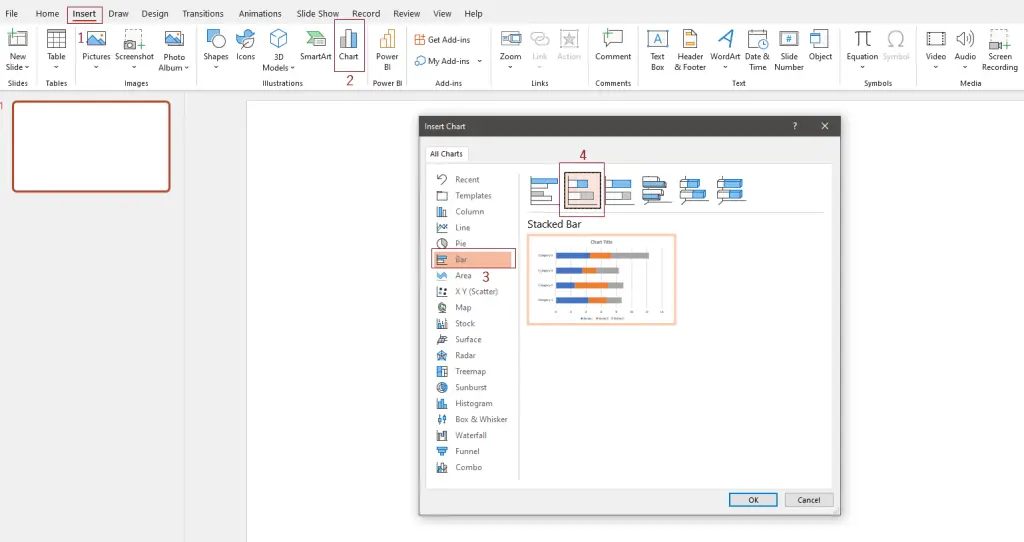
A standard bar chart will appear on your slide and a small Excel table with open next to it. The first column in the Excel table is called Categories . You can replace categories with the PhD tasks that you want to display. For instance, Literature Review, Interviews, Transcribing and Analysis. You can add more categories or delete existing ones by removing a row in the small Excel table.
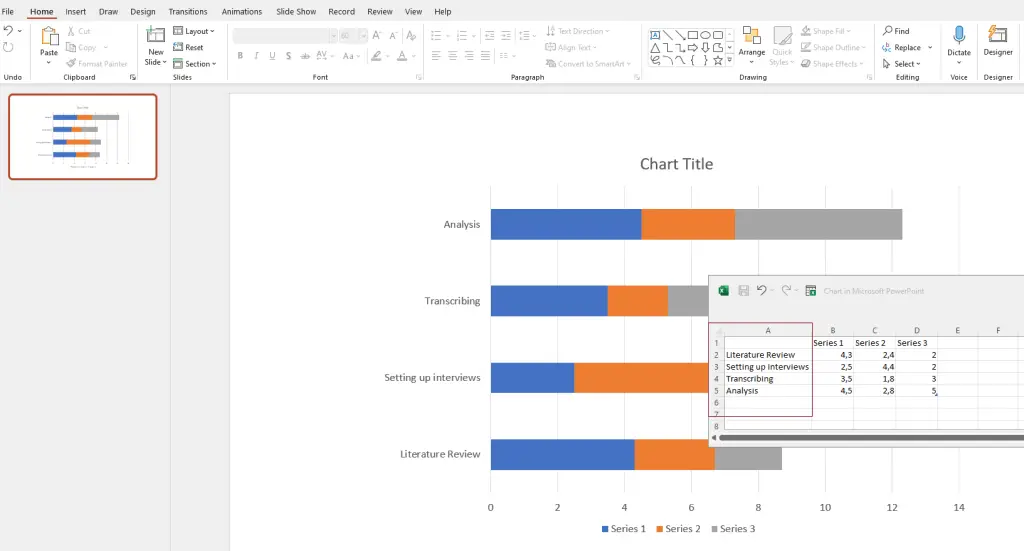
Next to the Categories (now tasks) column, you see three more columns: Series 1 , Series 2 , Series 3 . You can use these columns to showcase the length of tasks. Rename Series 1 into Start Date and Series 2 into End Date . Series 3 indicates the overall length. Depending on the timeframe you want to showcase, you can opt for instance for Length (weeks) or Length (months) .
In the example below, I decided to plan PhD tasks for a year. Thus, 1 means January, 2 means February, 3 means March and so forth. The length of tasks is also indicated in months:
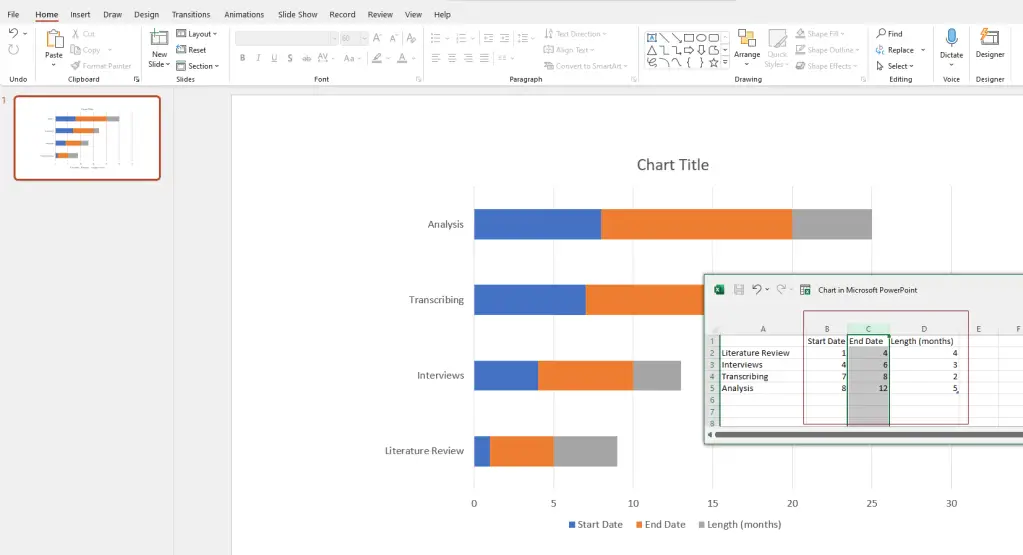
Next, click on your chart and three icons will appear in the upper-right corner next to it. Click on the bottom one, the Chart filters , remove the tick of the check box of End Date , and click on Apply. You will see that the bar chart will start to look like a Gantt chart:
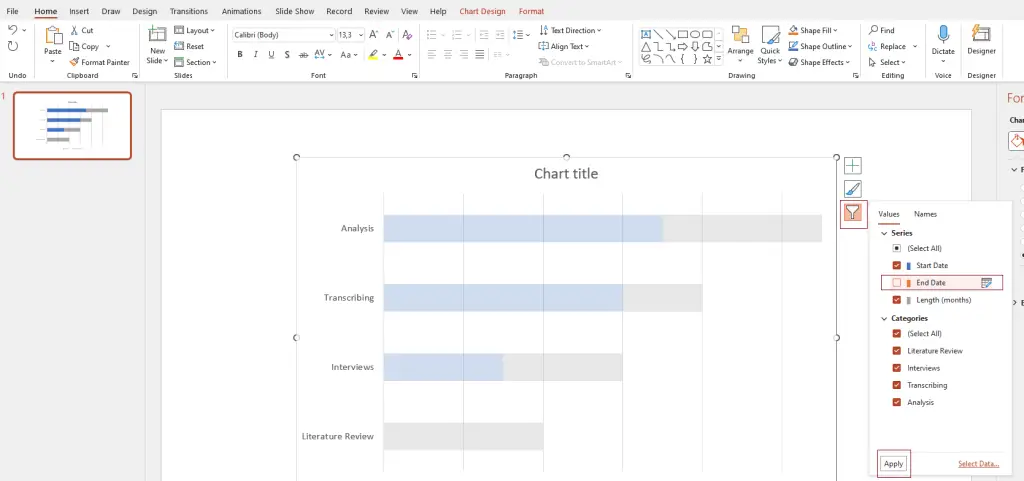
Now, the blue parts of the bar, indicating the Start Dates, need to be removed. Just click on one of them, and on the righthand side, Format Data Series should appear. Select No fill. Alternatively, in the upper menu, select Format , go to Shape fill, and select No fill .
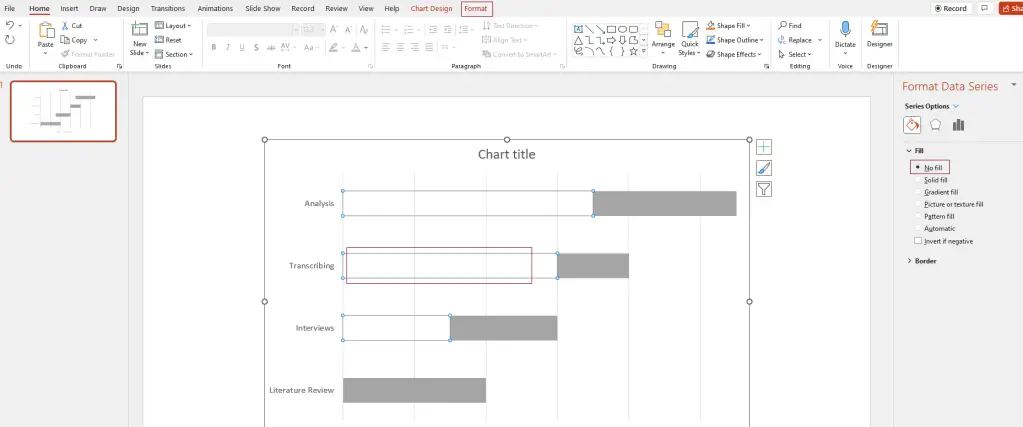
Now comes the fun part, namely decorating. You can add a chart title, colour the bars in the colour of your choice, edit the legend and the axis descriptions. Just play with it to explore the options.
One more thing I did was changing the value of the axis, because I want to illustrate the months of a year. Thus, it was a bit weird that the horizontal axis started with 0 and ended with 13 while I needed 1-12 to indicate each month of a year. You can simply change this by clicking on the axis. On the righthand side, Format Axis will appear. Go to Axis Options , Bounds , and enter 1 for Minimum and 12 for Maximum .
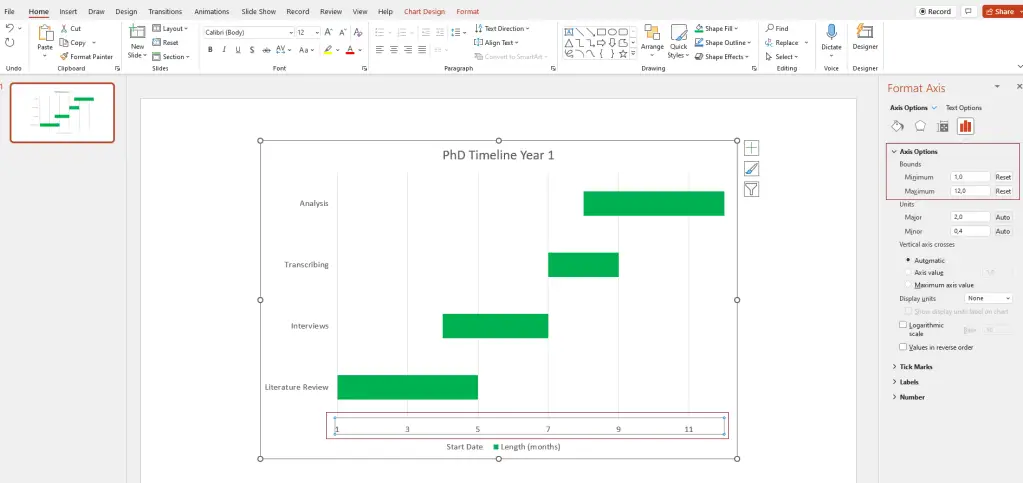
And voila! Your Gantt chart is ready.
The nice thing about learning how to create a Gantt chart in Microsoft PowerPoint is that you basically teaches you how to create one in a Word file as well! The process is very similar.
To start the process in Word, it is smart to first change the orientation of your page to Landscape . In the top menu, click on Layout , then select Orientation , then choose Landscape .
Next, select Insert , then Chart , and select a Stacked Bar chart again.
A basic bar chart will appear on your page:
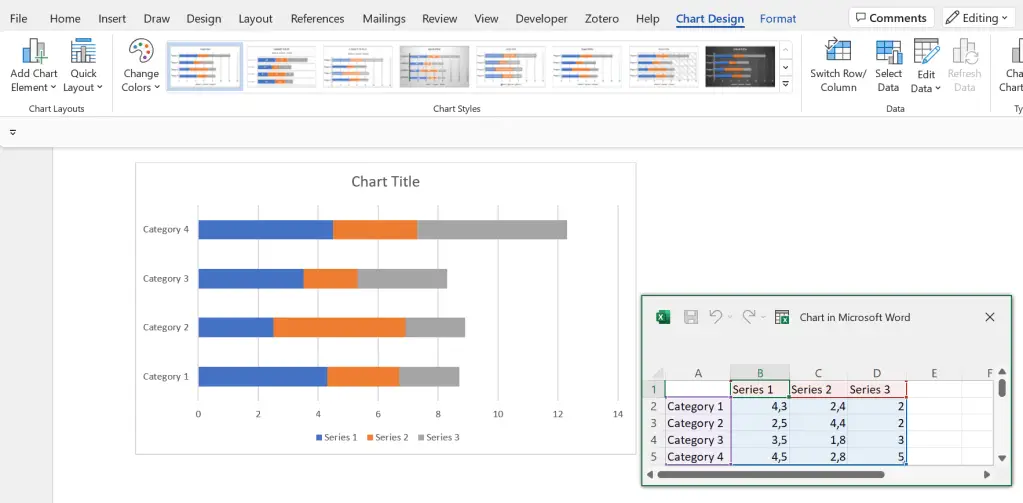
Looks familiar? Yes! From here, it is basically the same process as editing the bar chart in PowerPoint.
If you don’t want to go through the hassle of creating your own Gantt chart but are not convinced by any templates, you can make use of online tools and software.
There are some paid providers out there, but in my opinion, it is not worth paying to create an awesome PhD timeline.
You can use a free provider (or make do with one of the many Gantt chart templates that exist on the internet). One free online tool is the Free Online Gantt Chart Software :
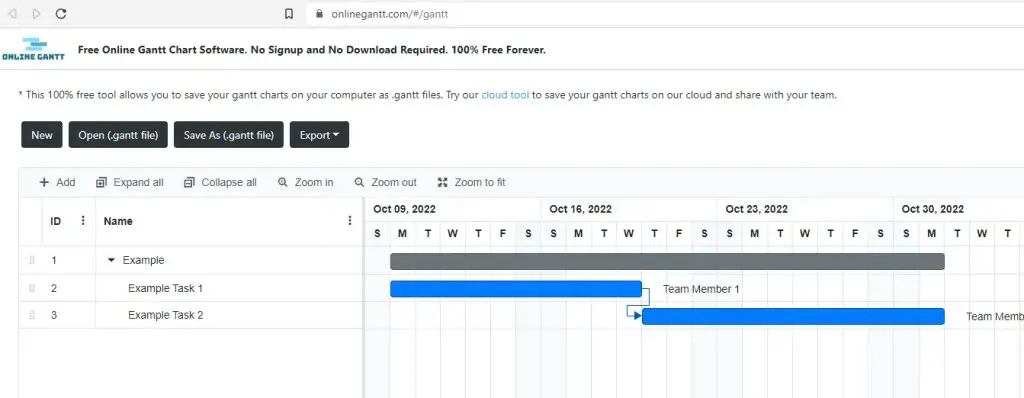
The site requires no signup. You can editing and simply start filling in the Gantt chart, and export it as an Excel, Image or PDF file when you are done!
PhD timeline Gantt chart templates
A great way to create a detailed Gantt chart in Microsoft Excel is by using Microsoft’s free Gantt project planner template . The level of detail and functionality exceeds those of simple, manually created Gantt charts. This makes this type of Gantt chart especially useful to track detailed PhD progress.
A useful Gantt chart template for PhD timelines in PowerPoint can be downloaded here via OfficeTimeline.com This Gantt chart is particularly great to provide a rough overview of plans over a longer period. For instance, with a few edits, you can illustrate a nice 3-year PhD timeline.
Useful Gantt chart templates for Microsoft Word can be downloaded here from TemplateLAB. I like these templates as they can be easily adjusted to the needs of a PhD timeline. For instance, a weekly Gantt chart template can be useful to establish a detailed plan with weekly objectives to keep your PhD progress on track.
PhD timeline Gantt chart examples
Using the template provided by Microsoft above, an example PhD timeline to track regular progress on tasks could look, for instance, like this:

Using the Gantt chart PowerPoint template by OfficeTimeline.com above, an example PhD timeline to present a plan for a 3 year PhD could look, for instance, like this:
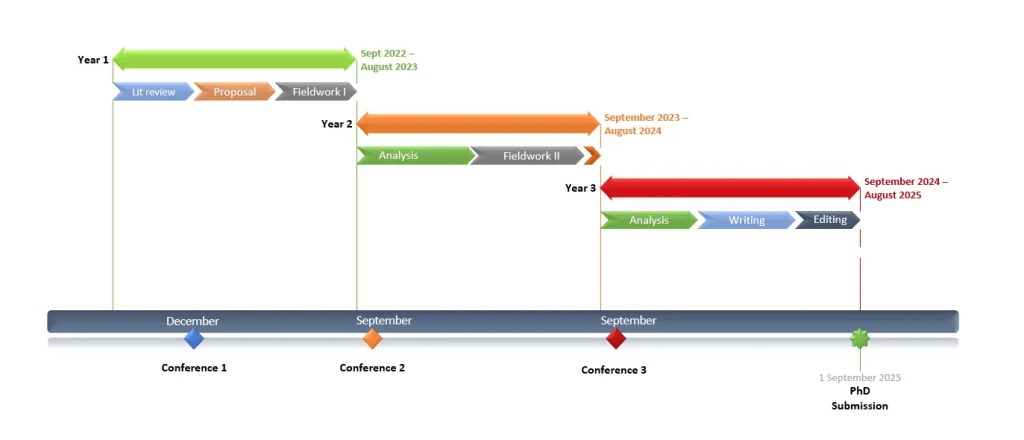
Using a weekly Gantt chart template from TemplateLab mentioned above, an example PhD timeline with weekly tasks and objectives could look, for instance, like this:
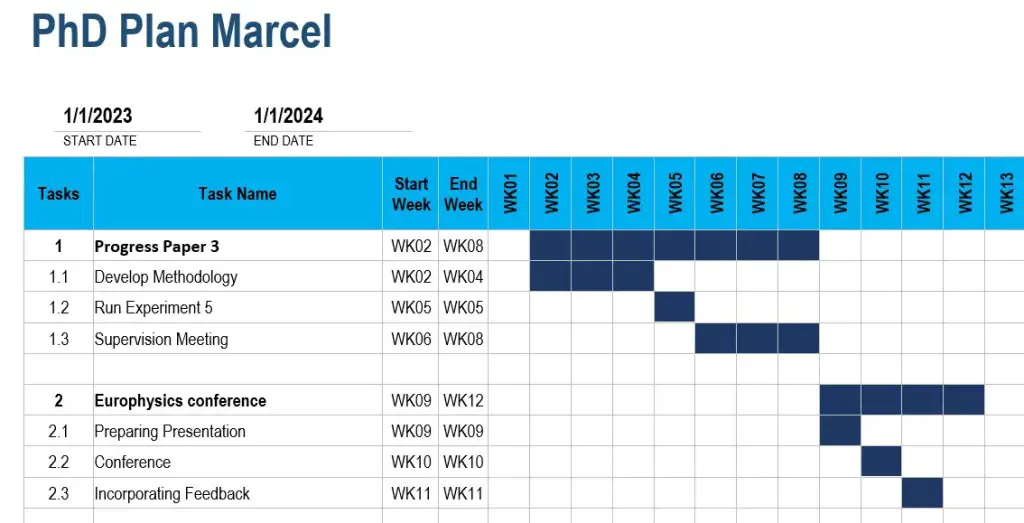
Get new content delivered directly to your inbox!
Subscribe and receive Master Academia's quarterly newsletter.
10 reasons NOT to do a master's degree
9 smart questions to ask a professor about graduate school, related articles.

Reviewer comments: examples for common peer review decisions

Types of editorial decisions after peer review (+ how to react)

Public speaking in academia and how to practice it

Reject decisions: Sample peer review comments and examples

- Jul 29, 2020
How I Made My PhD Completion Plan on Excel (With Template)
Updated: Dec 12, 2023
For the last few weeks, I've been working on my PhD completion plan. It's basically an excel spreadsheet that I'm using to track my progress and plan my time for the remainder of my PhD. My thesis is due August of next year (with a 6 month extension) so the clock is definitely ticking. But what started as a quick and basic gantt chart has quickly turned into a more complicated excel spreadsheet - and I love it so much I thought I'd share it with you all!
If you want to skip to accessing the excel template click the link below. But if you want to see how I made the document and how to use it, then keep on reading!
Basically, to make the Gantt charts I followed this Youtube tutorial:
I really wanted a Gantt chart that showed percentage progress as well as a general timeline, so I thought this tutorial was really useful for showing me how to do this!
If you start playing around with the Gantt charts in the template I've provided and run into any difficulties, particularly with things like changing the dates displayed on each chart, this is a good reference point as to how to fix problems that may arise. But of course, if you reach out to me for assistance with editing the spreadsheet, I'll do my best to help too!
The basic set up is that I have a colour coded table to the left of each Gantt chart within my file, that lists off each task with both my planned dates and my actual dates of start and completion for each task. Therefore, as I go along, if the dates that I actually do things don't correlate with my planned timeline, then I have a space to put the new dates down without losing my originally planned timeline. Basically, this set up allows me to have two options for what my Gantt chart looks like, I have the "Plan" view and the "Actual" view. I also have a column for % completion, so that on the "Actual" Gantt chart, it'll show me how far through I am with each task with a dark bar.

As I said, this all allows me to have two options for what my Gantt chart looks like, with both a planned and an actual dates option, I can control what I'm seeing on the chart using this nifty little drop down box:

By picking either actual or plan from the drop down box, it changes the display of the Gantt chart and what values come up in the second table entitled "Data Prep". You don't need to enter anything in the Data Prep table or do anything to it, it's all set up to get all the information it needs from the colour-coded table.
Then the sheet is set up to automatically create a Gantt chart like this one:

I've colour coded the chart based on three PhD Aims and general thesis writing. You'll notice that the dark bars indicate my percentage progress like I mentioned earlier, so if a bar is half way across, then the task is 50% complete. However, this will only show on the actual view, not the plan view.
If you change the dates for any of the planned or actual dates, it'll automatically update the Data Prep table and the corresponding Gantt chart.
Within the document, I have an overall Gantt chart to chart the whole PhD, but then I've also made tabs for each aim, where you can break each task down into smaller more actionable tasks and have a Gantt chart that displays those in detail. I've personally found this really useful so that I can both get an overall picture of my PhD, but also go into more detail for each aim or project when I need it.
I've also included a "Calendar View" option tab in the document. I don't think there's a way to automatically import dates of all your various tasks into the calendar, so you'll have to do it manually if this is a set up that would be beneficial for you. But personally, I liked being able to plan my day to day out on a calendar in order to know when I could put down tasks as planning to be performed on my Gantt charts. So I filled this calendar view out before I did any date planning on the charts. I obviously colour code these tasks for each aim and then general thesis writing in the same colours I've used to make the overall Gantt chart to make things easier to navigate and know what's going on at first glance.
I haven't included this in the template, but in my personal PhD completion plan document, I also have more tabs with experimental information like my immunohistochemistry antibody panels, so that I can quickly refer back to them while I'm looking at the timelines of completing my lab work for each project.
To access the most up-to-date version of this template, head to my new website at:
This excel sheet looks incredible and I cannot wait to use it: thanks for creating and sharing it with us!
Hello Lily,
My name is Hida and I am thankful for your kind sharing of this template. You have done a good deed and I also hope I can enjoy sharing my knowledge with others too. Thanks 😘
Love from Malaysia,
Hello, thank you so much for sharing this! very beneficial indeed. I need a little help, in extending the timeline beyond December 2021. Can you help me with it? Thanks a lot!
Hi Siti, the date axis are simply the dates on the gantt chart (top of the chart). If you click on those, the date axis will be selected
Hi, thanks for sharing and providing resources. Now that you are using notion how does this planning fit with that software? Or are you still using the gantt chart as your overall planning tool. Many thanks
Visit our commencement page for all information related to the 2024 Commencement Ceremony on May 10

Schedule By Year
During the first year of the PhD program, students prepare for formal candidacy by taking advanced courses in social work policy practice and research, and participating in faculty-directed research projects.
Students will also work with a faculty advisor in identifying an individual program of study that fulfills the PhD program requirements, consistent with your research and professional interests. Your mentor will also encourage you to pursue opportunities for professional and career development that may lie outside the traditional doctoral research experience.
When you have completed a minimum of 16 units (but not more than 24 units) of doctoral course work, the doctoral committee will assess your performance and determine your readiness to continue in the program. If permission is granted, a guidance committee is created.
- Establish faculty mentoring relationships
- Meet your faculty advisor
- Create an individualized study plan
- Develop your research area
- Determine your guidance committee of five faculty members
- Complete recommended first-year courses
- Participate in professional and career development workshops, seminars, lectures and conferences
Typical Schedule
Fall (first semester).
SOWK 760LIntroduction to Social Work Statistics (3) SOWK 762Social Work Research Methods I (3)
Students must also take two of the three substantive courses
SOWK 702Theories of Human Behavior in the Context of Social Environments (3) SOWK 703Explanatory Theories for Larger Social Systems (3) SOWK 733Policy Analysis and Advocacy in a Comparative Social Policy Context (3)
Spring (Second Semester)
SOWK 761LMultiple Regression in Social Work Research (3) SOWK 763Social Work Research Methods II: Research for Social Work Practice (3) SOWK 743Theories for Practice with Small Systems (3) SOWK 744Theories for Practice with Large Systems (3)
Second Year
The second year of the PhD curriculum is largely individualized to meet each student’s educational goals. Coursework is organized around a specific field of social work practice or a problem area, enabling students to gain knowledge of that field’s development and policies; one level of comparative practice theory; comparative explanatory theory; and advanced research methods. Students fulfill the requirement for the mastery of the content of their individualized course of study through a combination of at least three (2-unit) directed tutorials with members of the social work faculty, at least three university courses in other departments and an elective.
- Further develop faculty mentoring relationships
- Fulfill shadow teaching requirement with a faculty member in the PhD department
- Take courses in other departments or schools within the university
- Complete course requirements
- Work on directed research and publications
- Write papers and present at conferences
- Develop and submit grant and fellowship applications to fund research
Fall (Third Semester)
SOWK 790Faculty Tutorial 1 (2) SOWK 790Faculty Tutorial 2 (2) SOWK 764Advanced Multivariate Statistics (3) Course #1Other Department (3-4) Elective #1Internal/External (3-4)
Spring (Fourth Semester)
Course #2Other Department (3-4) Course #3Other Department (3-4) Elective #2Internal/External Statistics or Research Course (3-4) SOWK 790Faculty Tutorial 3 (2)
As a pre-requisite to candidacy for the PhD degree, students must pass a qualifying examination in their research area, which consists of a written paper of publishable quality and an oral defense. To become eligible, you must complete all core courses, at least six units of tutorials and at least 32 units of coursework in the doctoral program with a minimum grade point average of 3.0. After passing the qualifying exam, students advance to candidacy.
Once you are admitted to candidacy, you can choose your dissertation committee, consisting of three members of the guidance committee, one of whom must be from outside the school. Your dissertation committee will provide consultation in research, approve your dissertation, conduct the final oral examination and recommend you for the PhD degree.
- Explore dissertation topics
- Fulfill teaching facilitator requirements with a faculty member in the PhD department
- Complete your qualifying examination
- Determine your dissertation committee of three faculty members
Students who have completed all major course requirements in the program AND are not otherwise enrolled during the semester in which the qualifying examination is to be taken, must enroll in GRSC 800: Studies for Qualifying Examination. The one-unit GRSC 800 course maintains a student’s status as a full-time student in the program.
Fall (Fifth Semester)
GRSC 800Studies for Qualifying Examination (1)
Spring (Sixth Semester)
Fourth year.
The writing and successful defense of the dissertation is the final eligibility requirement for the PhD degree. Students are judged on the basis of their potential for independent scholarship and on the soundness of their work and its contribution to the chosen field of study. Dissertation planning begins earlier in the program, but becomes more focused at this stage.
The first step in the dissertation process is the development of a dissertation proposal, which should be completed in the first semester after passing the qualifying exam. Normally about 25-30 pages, the proposal should contain a clear statement of purpose, a rationale for the research, research questions or hypotheses, a review of pertinent literature and an explanation of the research methods to be used including the design, instrumentation, sampling procedures and plan for analysis.
Upon approval of the final draft of the dissertation by all members of the dissertation committee, the candidate must pass a general final oral examination. When the dissertation committee has certified the student has passed the defense, it recommends the candidate for the PhD degree.
- Complete dissertation proposal
- Work toward completing dissertation
- Fulfill teaching requirements
- Conduct job search
Students who have passed the qualifying examination must enroll in the SOWK 794 dissertation course, which maintains a student’s full-time status in the program.
Fall (Seventh Semester)
SOWK 794aDoctoral Dissertation (2)
Spring (Eighth Semester)
SOWK 794bDoctoral Dissertation (2)
Skip to Main Landmark (Press Enter)
Spartan Alert
Graduate students present their work at research and creativity showcase.
Posted on April 01, 2024
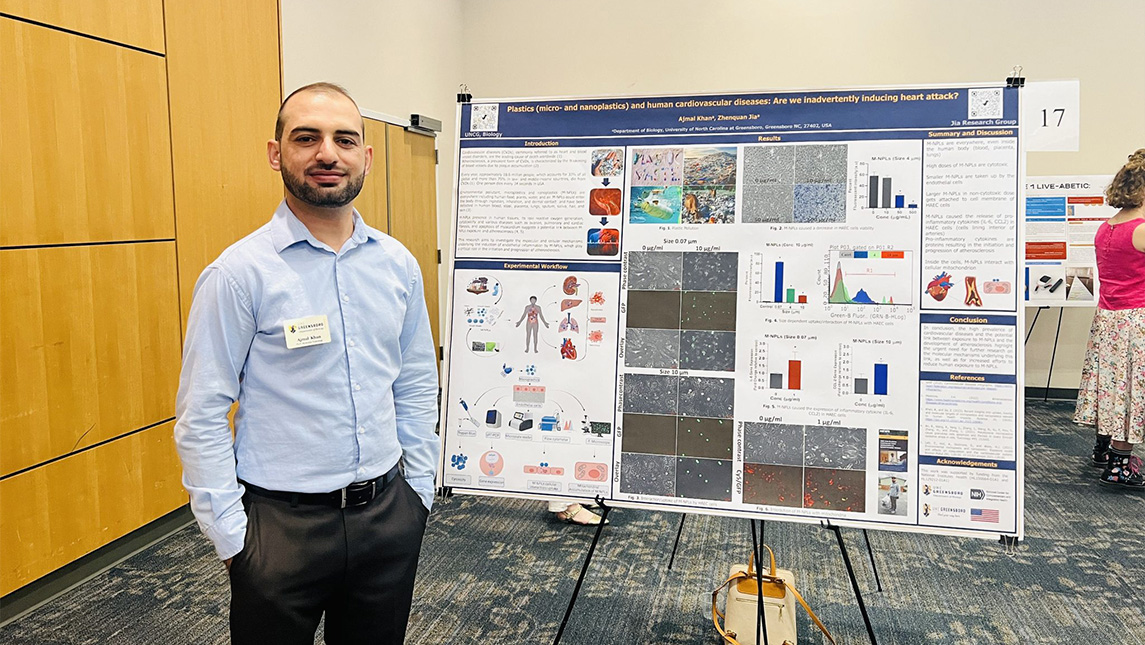
Please plan to join us as the UNC Greensboro Graduate School hosts the 12th Annual Graduate Research and Creativity Showcase: “Scholarship That Matters.” This showcase of talent will be held on Thursday, April 4 . Presentations will be from 1-3 p.m. in the Elliott University Center Cone Ballroom at UNCG.
New this year, the Graduate School is introducing People’s Choice Awards. Several People’s Choice Awards are available in addition to the judges’ category winners, and will be based on audience selections. Awards will be presented at 3:15 p.m.
Previews of the students and their research can be read here .
The purpose of the Showcase is to present the accomplishments of UNCG’s graduate students to the Greater Greensboro community and to provide a venue for students to communicate their research and creative activities to the public. Graduate students explain and present their work through posters.
This event is designed to showcase graduate research and creative work to a variety of non-specialized audiences. It is not intended to replicate an academic conference in a specific discipline, as students present their work to judges and individuals, not in their field of study.
Trending Stories

UNCG Offering Free Childcare For Qualifying Student-Parents
April 2, 2024
A federal grant awarded to UNC Greensboro’s Child Care Education Program is providing life-changing opportunities for qualifying stu...

Daria Clarke ’21 Coming “Home” With Garth Fagan Dance Company
As an undergrad, Daria “Toni” Clarke ’21 set aside ambitions to be a dermatologist or veterinarian for her first love, dance. Upon ...

Two Shooting Stars, Just Like Spartan Dad
April 1, 2024
Keyford Langley ’92, star UNCG point guard, still holds the program record for three-point percentage after three decades. But nothi...
- Print Friendly
Arizona lawmakers could move to a once-a-week work schedule. Here's why

The Arizona Legislature is preparing to move to a once-a-week work schedule for the session, with most of their legislative work done for the year but negotiations just starting on the state budget.
Senate President Warren Petersen and House Speaker Ben Toma, both Republicans, said they expect the Legislature to finish up most of the bills still under consideration this week. Starting next week, they said, lawmakers would very likely be coming in only on Wednesdays.
"I'm not going to take people away from their families and their jobs to come and pledge and pray and then send them back home," Petersen said. "I'm not going to make my members stay there while we negotiate the budget."
The shortened schedule has a couple of advantages for lawmakers in both chambers: It gives those with election challengers breathing room to work on their campaigns, and it allows them to continue earning per diem income without needing to work for most of the week.
Besides their $24,000-a-year annual salary, state lawmakers earn extra money each day the Legislature is in session, including weekends and holidays.
Lawmakers who live in Maricopa County — where the state Capitol is located — make an extra $35 a day for the first 120 days in session, which ends May 7. Those who live elsewhere in the state get $238 a day. The daily supplement drops after 120 days to $10 for Maricopa County residents and $119 for others.
So far, there's no sign lawmakers will take the long breaks they enjoyed last year due to disputes over bills, including Proposition 400, a transportation package that eventually passed and will be on November's ballot.
The 2023 session that unfolded after Democratic Gov. Katie Hobbs took office marked the Republican-dominated Legislature's biggest challenge with divided government in years. Hobbs and the Republicans, who hold one-seat majorities in each chamber, agreed on a $17.8 billion budget in mid-May but didn't end the session until July 31.
Hobbs has resisted budget negotiations for months, according to the legislative leaders, canceling numerous meetings without explanation, according to Petersen and Toma.
But now, "budget meetings are back on the schedule," Toma said. "So, barring any future derailments, we should finally start making progress."
Hobbs' spokesperson didn't return a message Monday about the negotiations. The governor on Tuesday said in response to questions by The Arizona Republic that she was "not aware" of any canceled budget meetings. Hobbs didn't directly refute statements that her office canceled them.
On the Legislature planning to meet once a week during budget negotiations, she noted the work left to be done.
"There's still a lot of pressing issues, bills to address the sober living home situation (and) affordable housing that I'm hoping to get to my desk," she said. "And, again, working on a budget that works for Arizona. So I'm hoping we can get those done in the near future."
Budget to take precedence as bill-making winds down
Creating a balanced budget is one of the most important tasks lawmakers and the governor must do, and by law should be completed by June 30, the end of the state's fiscal year.
Toma said he and Petersen have two meetings scheduled with Hobbs' office on April 2 and 4, and those so far haven't been canceled. But the two sides are still "out of whack" with each other, he added, and not just over how much each wants to spend. They don't yet agree on how much money exists to spend, Toma said, adding that new tax revenue projections set to be released next week should get Republicans and Democrats on the same page.
" We’ll see if our projections are right or if there needs to be significant changes," he said .
A surplus in last year's budget that led to millions in so-called "pork" expenditures became a shortfall when revenue predictions turned out to be several hundred million dollars less than expected. This year, Hobbs and the Legislature must adjust the current year's budget to the revenue reality and do the same with the budget for next fiscal year, which begins July 1.
A budget Hobbs proposed in January to absorb the revenue shortage involved large cuts to transportation projects and a plan to reform the state's private school voucher program that Republicans found untenable.
New schedule will allow some lawmakers to campaign
The Senate has about 75 bills remaining, while the House has about 100. The leaders said nearly all of those will be handled this week. The winning proposals in that bunch will get voted down, go to Hobbs' desk for her signature or veto, or head straight to the November ballot. Lawmakers only need one day a week to deal with the leftovers, they said.
Petersen said the legislative mix could include a new version of the Border Invasion Act that Hobbs has already vetoed or other border bills, though that depends on how the courts address a similar bill in Texas being challenged by the Biden Administration. Like the Texas bill, the Border Invasion Act would allow Arizona law officers to act as border control agents and allow state judges to issue deportation orders .
Toma's running for office in Arizona's 8th Congressional District, but the new schedule doesn't mean he'll have much extra time to campaign, he said. Petersen and Toma said they'll still be at the Capitol nearly every day in the planned budget talks.
They'll brief Republican lawmakers on Wednesdays, telling them how the negotiations are going and getting input from them on their wants and needs for their constituents.
"Toma and I are not dictators," Petersen said. "We're mediators."
He expected Democrats to get updates from their leaders, who would be apprised by Hobbs' office. He predicted the budget negotiation process could last weeks.
Senate Minority Leader Mitzi Epstein said Democrats would prefer a longer break if the intent is to drop the daily routine. That way, lawmakers could better manage their schedules, especially for those who hold jobs outside the Legislature.
Epstein said it's not just the budget causing delay. There are some bills still being worked on behind the scenes in what she called "tender negotiations."
House Majority Whip Teresa Martinez, a Casa Grande Republican, said she appreciates the coming shorter schedule. It'll give her more time to work her day job as the Hispanic outreach coordinator for Arizona Congressman Paul Gosar.
The extra days without floor sessions and committee hearings will also "give members some time to go out into the districts and go on and win their races," said Martinez, an incumbent who faces both Republican and Democratic challengers.
Reporters Mary Jo Pitzl and Stacey Barchenger contributed to this article.
Reach the reporter at [email protected] or 480-276-3237. Follow him on X @raystern .
- Election 2024
- Entertainment
- Newsletters
- Photography
- Personal Finance
- AP Buyline Personal Finance
- Press Releases
- Israel-Hamas War
- Russia-Ukraine War
- Global elections
- Asia Pacific
- Latin America
- Middle East
- Election Results
- Delegate Tracker
- AP & Elections
- March Madness
- AP Top 25 Poll
- Movie reviews
- Book reviews
- Personal finance
- Financial Markets
- Business Highlights
- Financial wellness
- Artificial Intelligence
- Social Media
Colorado brings in Hall of Fame defensive lineman Warren Sapp as grad assistant to work with Buffs
FILE - Former NFL player Warren Sapp walks on the field during practice at Washington Commander’s NFL football training facility, Aug. 9, 2022, in Ashburn, Va. Hall of Fame defensive lineman Sapp is headed back to the classroom in order to work on the field with the Colorado Buffaloes. Buffaloes coach Deion Sanders added Sapp to the staff as a graduate assistant. (AP Photo/Alex Brandon, File)
- Copy Link copied
Hall of Fame defensive lineman Warren Sapp is headed back to the classroom in order to be more of a hands-on coach for the Colorado Buffaloes.
Deion Sanders added the 51-year-old Sapp to the staff as a graduate assistant, which paves the way for him to work on the field with the team. Sapp, who’s taking classes, introduced himself to the Buffaloes as the senior quality control analyst — a mouth-full, he added — but that role would limit his involvement on the field.
“We’re building mansions here,” Sapp said to the team when he was introduced by Sanders to the group in a video posted on YouTube . “That’s why I’m here, to help you build your mansion.”
The University of Miami standout spent 13 seasons in the NFL with Tampa Bay and the Oakland Raiders. Sapp was the 1999 AP defensive player of the year and won a Super Bowl title with the Buccaneers following the 2002 season.
Sapp, who finished his career with 96 1/2 sacks, is looking forward to working alongside Sanders and the rest of the staff.
“I’ve been a Deion Sanders fan since I was 12 years old,” Sapp said in the video posted through “ Well Off Media ,” which is run by Deion Sanders Jr. “We’re all here for the man. Let’s go ride — championship time.”
In 2015, Sapp took a plea deal that spared him jail time in a Las Vegas criminal case involving a scuffle with his former girlfriend at a casino hotel swimming pool. The incident came months after Sapp was fired as an analyst for the NFL Network following his arrest in Phoenix for assaulting and soliciting a prostitute during Super Bowl weekend. He pleaded guilty to both charges, and the solicitation charge was dropped after he completed a diversion program.
“Warren Sapp successfully completed all of the necessary steps required of anyone who is employed at CU Boulder, including a background check,” Colorado said in a statement issued to The Associated Press. “Furthermore, athletic director Rick George personally met with Warren to clearly articulate the department’s standards and expectations, to which he acknowledged and agreed.”
Deion Sanders lauded Sapp’s pedigree — pointing out he had a gold jacket, too — and his trash-talk game.
“That’s how we meet, talking junk,” Sanders said to the team.
Sanders has been busy tinkering with his coaching staff following a 4-8 showing in his first season at Colorado. He added Robert Livingston as the defensive coordinator and brought in Phil Loadholt to shore up a shaky offensive line to better protect his QB son, Shedeur Sanders. The team is sticking with Pat Shurmur as the offensive coordinator after he took over play-calling duties during last season.
Colorado is gearing up for its spring game on April 27 at Folsom Field . It will be aired on the Pac-12 Network, the team announced Monday, and followed that night by a concert featuring Lil Wayne at CU Events Center.
The Buffaloes are moving from the Pac-12 to the Big 12 next season.
Get alerts on the latest AP Top 25 poll throughout the season. Sign up here .
AP college football: https://apnews.com/hub/ap-top-25-college-football-poll and https://apnews.com/hub/college-football
- CBSSports.com
- Fanatics Sportsbook
- CBS Sports Home
- NCAA Tournament
- W. Tournament
- Champions League
- Motor Sports
- High School
- Horse Racing
Men's Brackets
Women's Brackets
Fantasy Baseball
Fantasy football, football pick'em, college pick'em, fantasy basketball, fantasy hockey, franchise games, 24/7 sports news network.
- CBS Sports Golazo Network
- March Madness Live
- PGA Tour on CBS
- UEFA Champions League
- UEFA Europa League
- Italian Serie A
- Watch CBS Sports Network
- TV Shows & Listings
The Early Edge
A Daily SportsLine Betting Podcast
With the First Pick
NFL Draft is coming up!
- Podcasts Home
- Eye On College Basketball
- The First Cut Golf
- NFL Pick Six
- Cover 3 College Football
- Fantasy Football Today
- Morning Kombat
- My Teams Organize / See All Teams Help Account Settings Log Out
2024 March Madness TV schedule: How to watch NCAA Tournament, Final Four live stream, tip times, announcers
The complete television and streaming schedule for how to watch march madness 2024.
All that's left is the Final Four of the 2024 NCAA Tournament as we inch closer to crowning a national champion in men's college basketball. After starting with 68 teams just 13 days ago on Selection Sunday, only four remain with three games left until a champion is determined.
Though the top eight teams in the nation entering the Big Dance were all still alive entering the Sweet 16 for just the fifth time since the NCAA Tournament expanded to 64 teams in 1985, only two of them remain. On Saturday, No. 1 seed UConn ran through No. 3 seed Illinois on its way to a 77-52 victory, while No. 1 seed Purdue won a hard-fought battle 72-66 over No. 2 seed Tennessee on Sunday.
Joining them in the Final Four is No. 4 seed Alabama, which won 89-82 over football rivalry No. 6 seed Clemson, and No. 11 seed NC State -- the Cinderella of this affair -- after a 76-64 come-from-behind win over ACC rival No. 4 seed Duke.
Veteran Ian Eagle steps in as the lead play-by-play announcer for the Final Four, replacing the legendary Jim Nantz, who stepped away in 2023. Eagle will lead mainstays Bill Raftery, Grant Hill and reporter Tracy Wolfson on the top announcing team.
For the entire 2024 NCAA Tournament, CBS and TBS are leading the way primarily televising 21 games apiece, while truTV and TNT carried 13 and 12, respectively. The Final Four will simulcast across TBS and TNT. You can also watch the final three games of the NCAA Tournament on the March Madness Live app and on Max's B/R Sports Add-On.
From the Selection Show all the way until the playing of "One Shining Moment" after a champion is crowned, CBS Sports and TNT Sports will be bringing you the magic.
Let's take a look at the 2024 March Madness announcing teams as well as the remaining schedule for the 2024 NCAA Tournament.
2024 March Madness announcing teams
Play-by-Play | Analyst(s) || Reporter * Regional Weekend announce teams
- Ian Eagle | Bill Raftery, Grant Hill || Tracy Wolfson*
- Brian Anderson | Jim Jackson || Allie LaForce*
- Kevin Harlan | Dan Bonner, Stan Van Gundy || Andy Katz*
- Andrew Catalon | Steve Lappas || Evan Washburn*
- Lisa Byington | Steve Smith, Robbie Hummel || Lauren Shehadi
- Spero Dedes | Jim Spanarkel || Jon Rothstein
- Tom McCarthy | Deb Antonelli, Avery Johnson || AJ Ross
- Brad Nessler | Brendan Haywood || Dana Jacobson
2024 NCAA Tournament schedule, dates
Saturday, April 6 State Farm Stadium -- Glendale, Arizona
National Championship
Monday, April 8 -- 9:20 p.m. (TBS / TNT) State Farm Stadium -- Glendale, Arizona
Our Latest College Basketball Stories
2024 Final Four schedule, live stream, TV information
Kyle boone • 2 min read.
Alabama roster, staff rebuild sparked historic run
Cameron salerno • 4 min read.
Indiana State vs. Utah odds, NIT semifinal picks
Cbs sports staff • 2 min read.
NIT quarterfinals: Indiana State wins, Ohio State falls
Cameron salerno • 2 min read.
2024 NCAA Tournament schedule, scores by region
Cameron salerno • 3 min read.
Expert brackets: Predictions for NCAA Tournament 2024
Kyle boone • 6 min read, share video.

2024 NCAA Tournament: How to watch live, TV tip times

Keady's legacy part of Purdue's Final Four run

Prompt rebuild key to Alabama success

Experts predict who wins Final Four

Final Four lookahead: Phoenix field finalized

NC State's Burns is March's latest hero

Who's playing in McDonald's All-American Game

Oklahoma State hires Western Kentucky's Lutz

Coaching changes tracker: Latest intel on hirings

NIT semis: Seton Hall-Georgia; Utah-Indiana State

Costs for work visas and green cards in U.S. are going up — a lot

Applying for a work visa or green card just became more expensive. The new fees, including some which are significantly higher, go into effect today, April 1.
No, this isn’t an April Fool’s joke.
The U.S. Citizenship and Immigration Services hasn’t raised many of its fees in more than seven years. Unlike other agencies, the overwhelming majority, or 96%, of its funding comes from filing fees and 4% comes from congressional appropriations.
The number of immigration filings fell during the Covid-19 pandemic and so did revenue, at one point as much as 40 percent, according to USCIS. The agency implemented a hiring freeze during the pandemic while other positions became vacant as employees left. But the caseload eventually shot up to pre-pandemic levels and now there’s a serious backlog.
“The fee schedule from 2016 no longer covers operational costs to timely adjudicate USCIS immigration and naturalization benefits,” USCIS said on its website. “We need higher fees to cover the cost of doing business and better avoid the accumulation of future backlogs.”
Employers that hire foreign workers and immigration attorneys who work with these companies have been closely following the fee hikes, which the federal government announced it was planning to do over a year ago.
“We’re not talking about one or 2% increases,” said Stephanie Pimentel, partner and co-head of the Dallas office of BAL, a global immigration law firm. “When you pair the base line increases together with that additional new fee that is being leveraged on every new employment-based petition, you’re looking at increases of two and 300%.
The visa fee increase took effect despite an effort to stop USCIS from implementing them. Late last week, a federal district court judge denied a motion from an employer group and other plaintiffs for a temporary restraining order before April 1.
Among the changes, the fee for an H-1B visa petition increased from $460 to $780 and the registration fee for an H-1B shot up from $10 to $215.
One of the biggest changes is a new $600 Asylum Program Fee companies must pay when filling an employment-base petition.
“This is a new tactic of USCIS as part of their fee regulation is to start having U.S. businesses cover the cost of the asylum program because they have the ability to pay it, which I don’t know if I would agree on all businesses,” said Emily Neumann, an immigration attorney and managing partner at Reddy & Neumann, PC in Houston.
Neumann writes an immigration-related blog under the name Immigration Girl and co-hosts a weekly video she shares on social media.
The law firm BAL conducted a survey of employers about the feds’ new fees and found that more than half, or 57% of respondents, said the increase wouldn’t affect their ability to complete globally.
Pimentel said this is most likely because companies know other employers who hire foreign workers have to pay the same fees.
“Still, 43 percent saying that there’s going to be an impact on their ability to compete globally is significant,” Pimentel said, adding that 60% of businesses said they plan to file the same number of petitions while 40% said the would file fewer of them or offer fewer benefits.
Some of those benefits include the employer paying for their employees’ dependents to have their status to stay in the country extended. Others might pay the premium processing fee so their employee’s petition will be expedited. Under the new fee structure though, some employers may no longer cover those, leaving it to their employee(s).
Another change affects those seeking a green card or adjusting their status. The cost of an application is now $1,440, up from $1,225. And USCIS has added two additional fees for those applications – one for filing for interim work authorization and another for filing for an interim work permit.
You can find the entire new filing fee schedule here .
Got a tip? Email Stella M. Chávez at [email protected] . You can follow Stella on Twitter @stellamchavez .
KERA News is made possible through the generosity of our members. If you find this reporting valuable, consider making a tax-deductible gift today. Thank you.


IMAGES
VIDEO
COMMENTS
Depending on your schedule, this might be across a full week or a few days. Universities rarely impose a number or pattern of work hours on PhD students, so it'll be up to you to manage your time effectively. Most of the time, attendance is to do with regular meetings, set departmental deadlines and timely submission of written work.
Example: Planning year 2 of a 3-year PhD. Maria completed her first round of data collection according to plan, and starts the second year of her PhD with a lot of material. In her second year, she will focus on turning this data into two journal articles. Months 1-2: Maria works on her data analysis.
A PhD research plan or schedule can be prepared using the GANTT chart which includes a month, semester or year-wise planning of the entire PhD research work. First, enlist goals and objectives. It's not about your research objective enlisted in your proposal. I'm talking about the objectives of your PhD.
Guidelines for how to make & use the timeline throughout your PhD. 1. Example & download: I draw below an example for the institute where I did my PhD: the Institute of Biology at the University of Fribourg in Switzerland. Therefore, it is designed for a 4-year PhD program with annual committee meetings and for students who spend a lot of time ...
The first two years of a PhD program are mainly made up of classes and the beginning stages of research. Deborah Small, the doctoral coordinator for the Marketing program, said, "It starts with heavy duty coursework and a lot of specific requirements. At the end of your first year, there are qualifying exams on all the core marketing courses.
Communicate with your supervisor. 10. Seek support. 11. Stay motivated. 12. Take breaks. 50 Tips to Oranize PhD Research Work. The journey of pursuing a PhD can be an exciting and rewarding experience, but it can also be overwhelming at times.
A successful PhD journey begins with a solid plan that includes a PhD timeline. A thought-through and well-designed PhD timeline requires some time but can be accomplished in a few simple steps. Contents Why a clear PhD research timeline mattersStep 1: Decide what to include in your PhD timelineStep 2: Discuss your provisional PhD timeline
A PhD schedule takes adjustment, but the strategies that work for doctoral studies carry throughout an academic career. Adjusting to a PhD schedule can be a challenge. Classes will take up a decent amount of your time for the first few years of a program. After completing the required courses, independent research becomes the main focus.
The PhD Planner is a dedicated ally designed to empower you on this transformative journey. With The PhD Planner, you have the power to anticipate and prioritize your tasks effectively. Each day, you can meticulously plan your research activities, allocate time for writing, reviewing literature, and attending seminars.
The simple answer is yes, you can work while studying a PhD and in fact, many do. The most common form of work is teaching during your PhD. But some students may also have part-time (or full-time jobs outside of the university). Depending on the amount of work you plan to undertake, you will have to consider whether it would be better to do ...
A PhD student's schedule is very different to anything that people have experienced in undergraduate or masters level education. Depending on the country that you are doing your PhD in, you may have classes alongside your dedicated research time. It is likely that you will work many hours more than a typical full-time job and may have some ...
Creating a timeline for a 3-year PhD program requires careful planning, as you'll have multiple milestones and tasks to complete. This timeline may vary depending on your specific field, institution, or country, but here is a general outline you can use as a starting point: Year & Quarter. Activity/Milestone.
Attend the program orientation to understand specific graduation requirements. Make a list of technical events such as conferences, committee meetings, PhD viva voce, presentations, qualification examination, etc. Manage your PhD timeline term-wise or month-wise. Make a list of events on priority-basis.
Transfer of registration from MPhil to PhD (between 9-18 months, but as. early as reasonable). 24 months: Submission and assessment of second year progress report on research log. Agreement of thesis structure and strict timetable. for thesis writing . 30 months (not less than 4 months before expected date of submission
A daily routine is crucial for PhD students, as it helps to manage the various demands of graduate school and maintain a healthy work-life balance. A well-organized schedule allows you to prioritize tasks and responsibilities, making it easier to stay focused and avoid feeling overwhelmed. In addition, having a consistent routine can help you ...
PhD work can be demanding and often 'spill over', requiring more time and attention at various stages of the PhD. ... we recommend scheduling your rest time and sticking to it as ardently as you would with your work schedules. For example, you could schedule in 15-minute breaks throughout the working day (using a work timer, like the ...
With the right PhD work plan in place, you can maintain PhD Work life balance. ... So, creating a standard schedule sample to manage PhD workload is not advisable. However, here are some tips and advice for PhD students to make this process of creating an optimal PhD student lifestyle for themselves easier and more enjoyable. 2,3.
Purpose of the PhD research plan • Develop a PhD project with realistic goals that can be achieved within the timeframe of the PhD period (normally 3-4 years). • Ensure that the PhD student and PhD supervisor(s) are aligned wrt goals of the project and the work plan/schedule. • Critically evaluate the overall objectives.
Step 1: List all the deliverables expected of your PhD program. In this example, the PhD program has the following requirements: Coursework, divided into 4 modules each lasting 2 weeks. All 4 modules need to be completed within the first year of study. A comprehensive written exam at the end of the fourth module.
Manually creating a PhD timeline Gantt chart in PowerPoint is a bit easier than in Excel. Therefore, I will explain the process here. First, you need to open a blank PowerPoint slide. Then click on Insert (1.), then Chart (2.). A popup will appear.
How I Made My PhD Completion Plan on Excel (With Template) For the last few weeks, I've been working on my PhD completion plan. It's basically an excel spreadsheet that I'm using to track my progress and plan my time for the remainder of my PhD. My thesis is due August of next year (with a 6 month extension) so the clock is definitely ticking.
Second Year. The second year of the PhD curriculum is largely individualized to meet each student's educational goals. Coursework is organized around a specific field of social work practice or a problem area, enabling students to gain knowledge of that field's development and policies; one level of comparative practice theory; comparative explanatory theory; and advanced research methods.
PhD Program in Pharmacology and Physiology Graduate School of Biomedical Sciences and Professional Studies College of Medicine EAATs for stroke: to modulate or not to modulate. Approx. 3:20 to 3:40 p.m. EDT Arielle D'Elia PhD Program in Biomedical Engineering School of Biomedical Engineering, Science, and Health Systems
Graduate students explain and present their work through posters. This event is designed to showcase graduate research and creative work to a variety of non-specialized audiences. It is not intended to replicate an academic conference in a specific discipline, as students present their work to judges and individuals, not in their field of study.
The Arizona Legislature is preparing to move to a once-a-week work schedule for the session, with most of their legislative work done for the year but negotiations just starting on the state budget.
Deion Sanders added the 51-year-old Sapp to the staff as a graduate assistant, which paves the way for him to work on the field with the team. Sapp, who's taking classes, introduced himself to the Buffaloes as the senior quality control analyst — a mouth-full, he added — but that role would limit his involvement on the field.
From the Selection Show all the way until the playing of "One Shining Moment" after a champion is crowned, CBS Sports and TNT Sports will be bringing you the magic.
Pay Grade/Pay Range: Minimum: $48,600 - Midpoint: $60,800 (Salaried E7) Department/Organization: 214231 - Civil Const and Env Engineering Normal Work Schedule: Monday - Friday 8:00am to 4:45pm Job Summary: The Postdoctoral Fellow provides for an internship and continuation of scholarly activity and research after achieving the PhD or other doctoral degree under the direction of a senior ...
The U.S. Citizenship and Immigration Services has raised the cost of an H-1B visa petition from $460 to $780. The cost for a green card also has increased significantly. Applying for a work visa ...